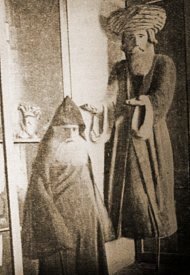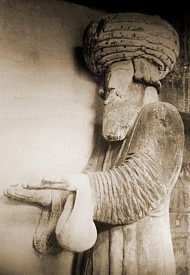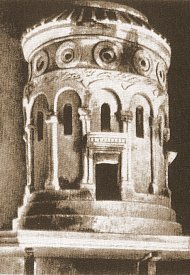HistoryIn 1906, during Nikoli Marr's excavation of the ruins of King Gagik's church of Saint Gregory, a large statue of King Gagik holding a model of his church was found in fragments. The statue was originally located in a niche high up in the north facade of the church.
The statue was reassembled, using iron rods to hold the fragments together, and was kept within the Minuchihr mosque which the excavators had turned into a small museum. The statue was later "lost" in uncertain circumstances at the end of the First World War, and only a few photographs survive of it intact. A surviving fragment of the statue (the upper left portion of Gagik's torso) is now in the Erzurum archeological museum. Exactly how, and when (it was definitely there by 1993), it got there is unknown. According to the museum staff it was found somewhere in the vicinity of Erzurum and the finder brought it to the museum by car. Description
Donor portraits carved in high relief are not uncommon on Armenian churches. However, this statue was unique in that it was almost free-standing, the only known example from Armenia. At 2¼ meters high, the statue was larger than life size, and traces of colour found on the stone indicated that it was originally painted. King Gagik was depicted wearing a long red kaftan and a large white turban, a costume that illustrated cultural links between the Bagratid court and the Arab Caliphate. Around his neck he wore a crucifix.
The statue held in its hands an accurate scale model of the church. Unfortunately, the upper portion of the model was never found - so the exact appearance of the church remains unknown. This model is also now lost. |
|
 3. A full height view of the statue |
 4. A close-up view of the statue |
 5. The model of the church |
AnalysisDonor portraits carved in high relief are not uncommon on Armenian churches. However, this statue was unique in that it was almost free-standing, the only known example from Armenia. There are no known examples of figurative sculpture in medieval Armenia as naturalistic as the statue of King Gagik.
However, it would be incorrect to assume that this means it was a creation of foreign craftsmen. As mentioned earlier, sculptural compositions portraying the founder or benefactor of a church symbolically presenting his church to the viewer (and to God) are often found on medieval Armenian churches. The best known example of this is the depiction of King Gagik Artzrouni on the walls of the early 10th century church on Acht'amar island, lake Van. Although the donors in such compositions are often depicted two-dimensionally, the miniature churches are usually three-dimensional and extremely accurately rendered, suggesting that they are based on actual architectural models used in the design and construction of the buildings. The most similar example to the statue of King Gagik can be found on the east facade of the main church of Haghbat Monastery, which was within the territory of the Kingdom of Ani. This church, called Surb Nishan, was completed in the year 991 and is believed to have also been designed by Trdat, the architect of King Gagik's church at Ani. The sculpture here represents two donors holding a model of their church. The figure on the right represents King Smbat of Ani, and it closely resembles the Gagik statue, although not quite as realistic and three-dimensional. In October 989 an earthquake caused the collapse of part of the dome of Haghia Sophia in Constantinople, the most important church in Christendom. Trdat was summoned to Constantinople to organise the repair of the dome, which was completed by 994. It is possible that the form of the Gagik statue was influenced by the many statues from classical Greece and Rome that still existed in Constantinople. Such statues are also known to have existed in pagan Armenia, but the centuries of control by the Zoroastrian Persians and then the Muslim Arabs (both unsympathetic to the use of figurative sculpture in religious art) had probably wiped out all traces of that earlier tradition. |
|